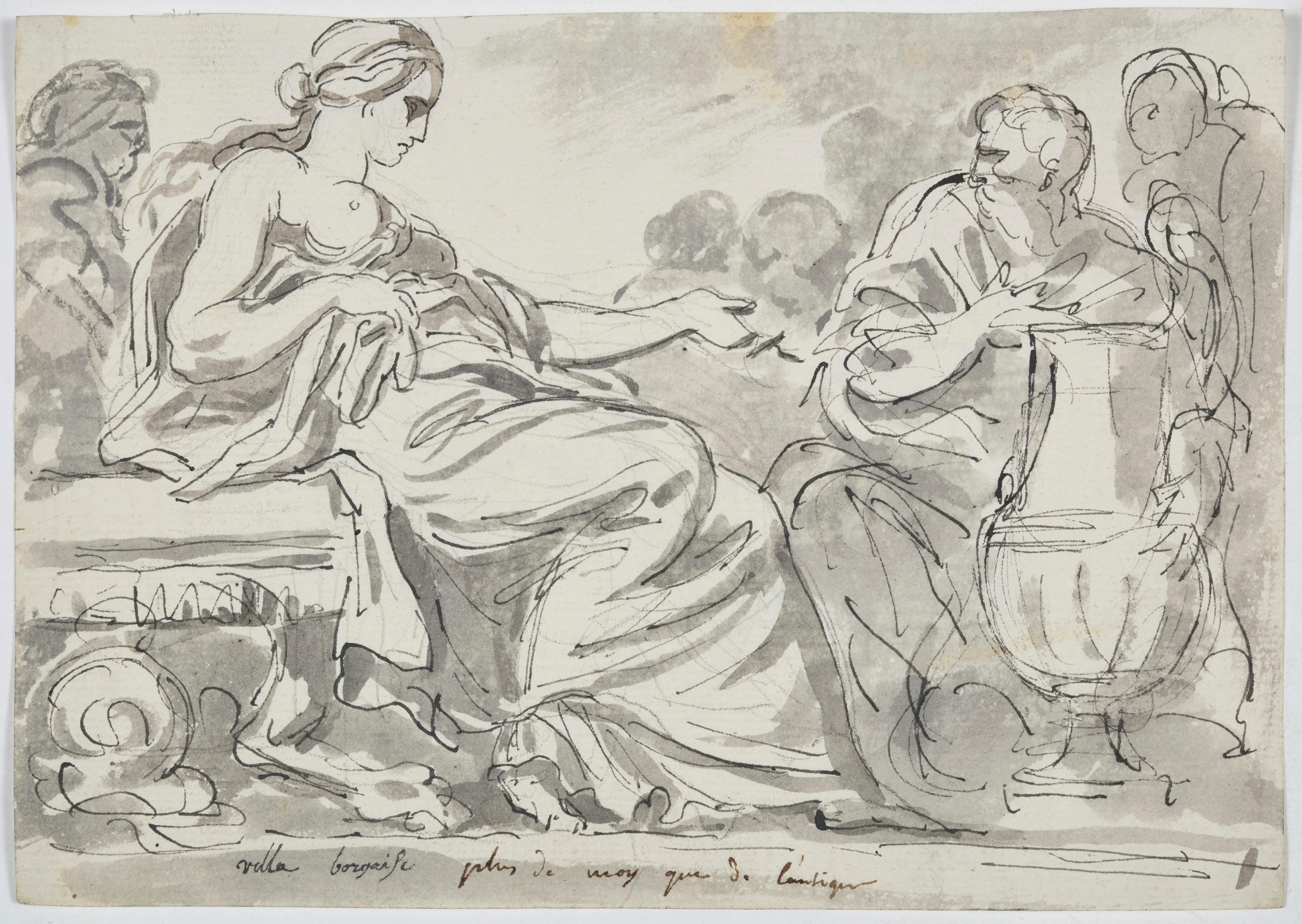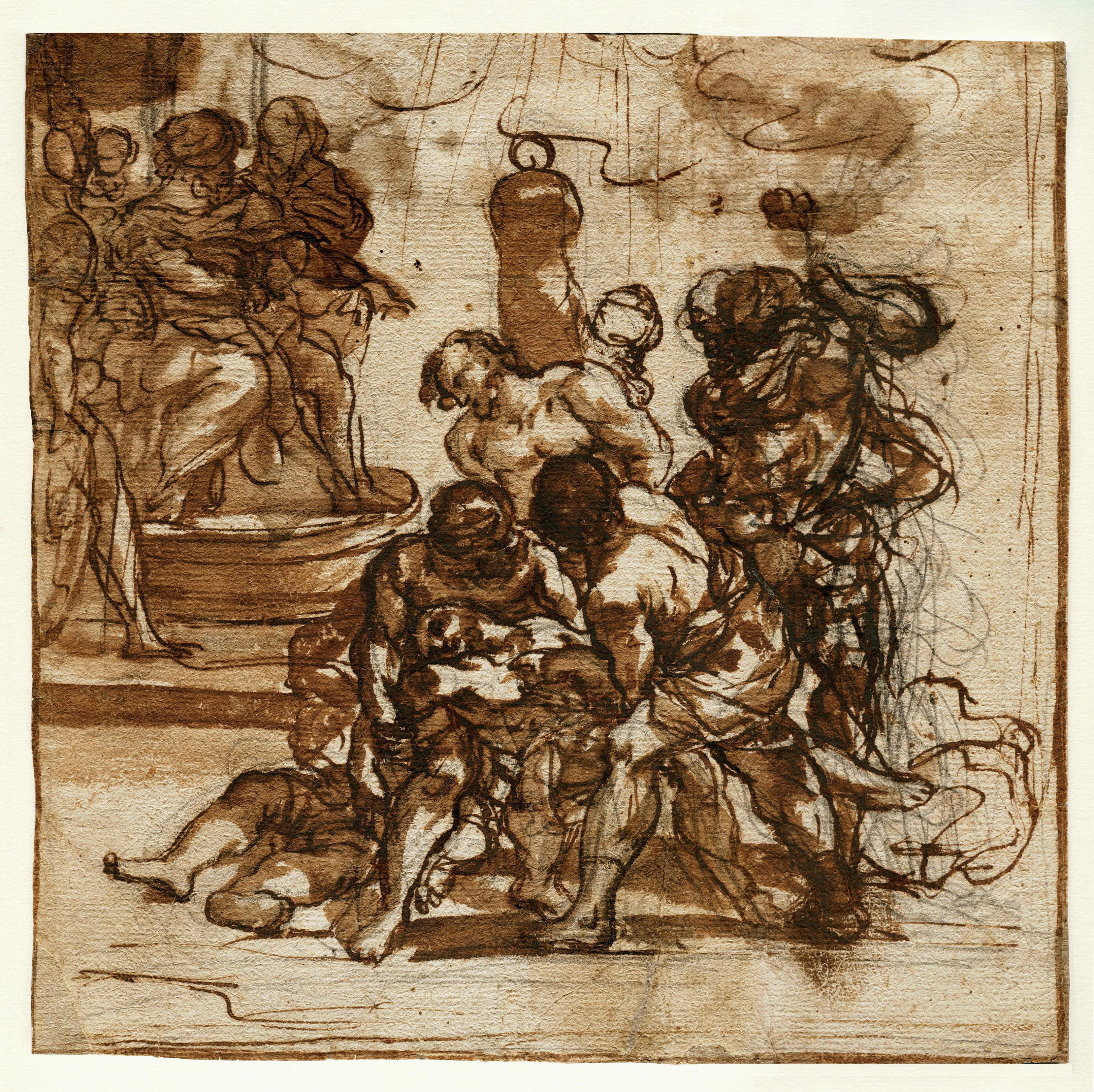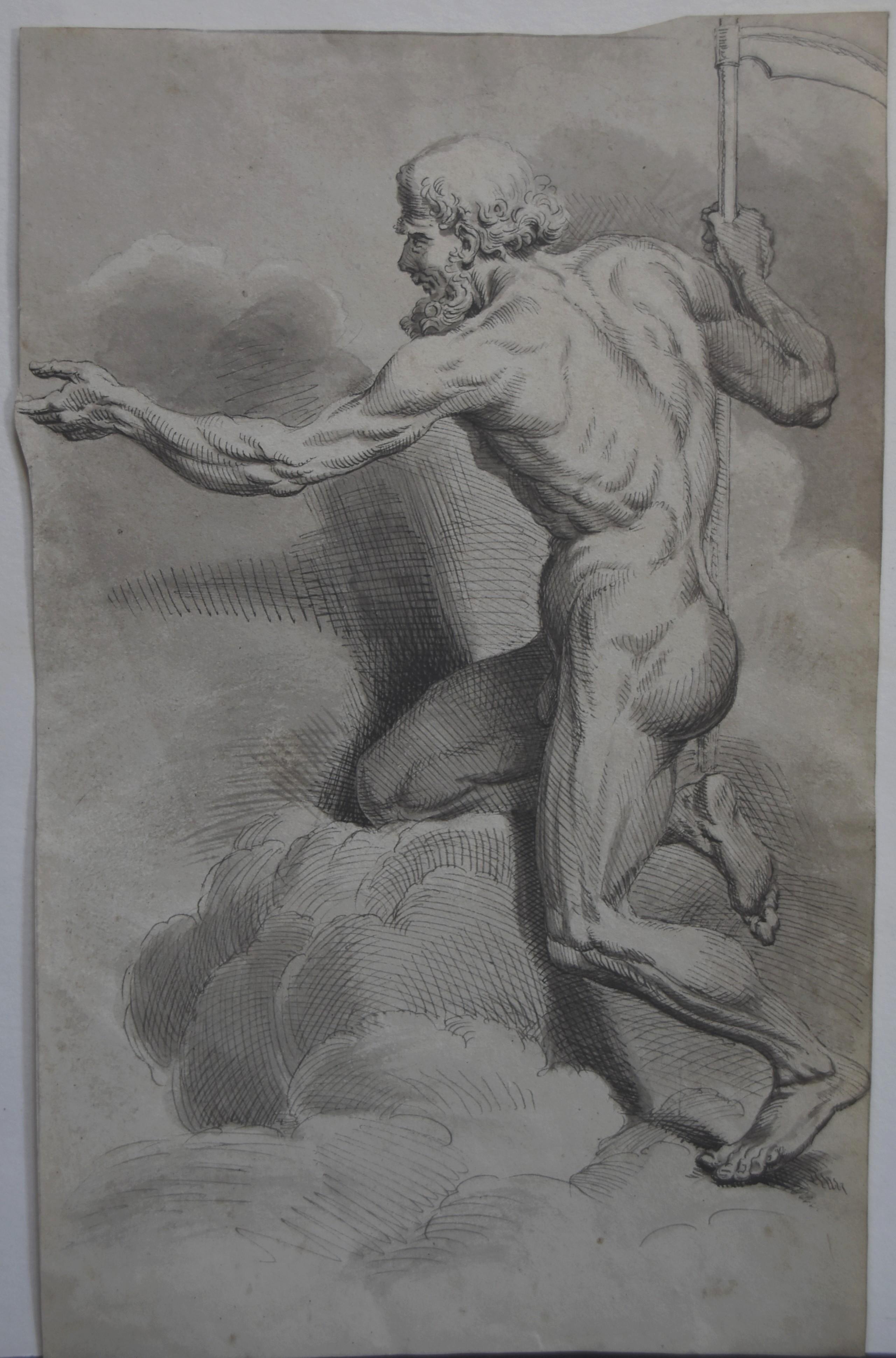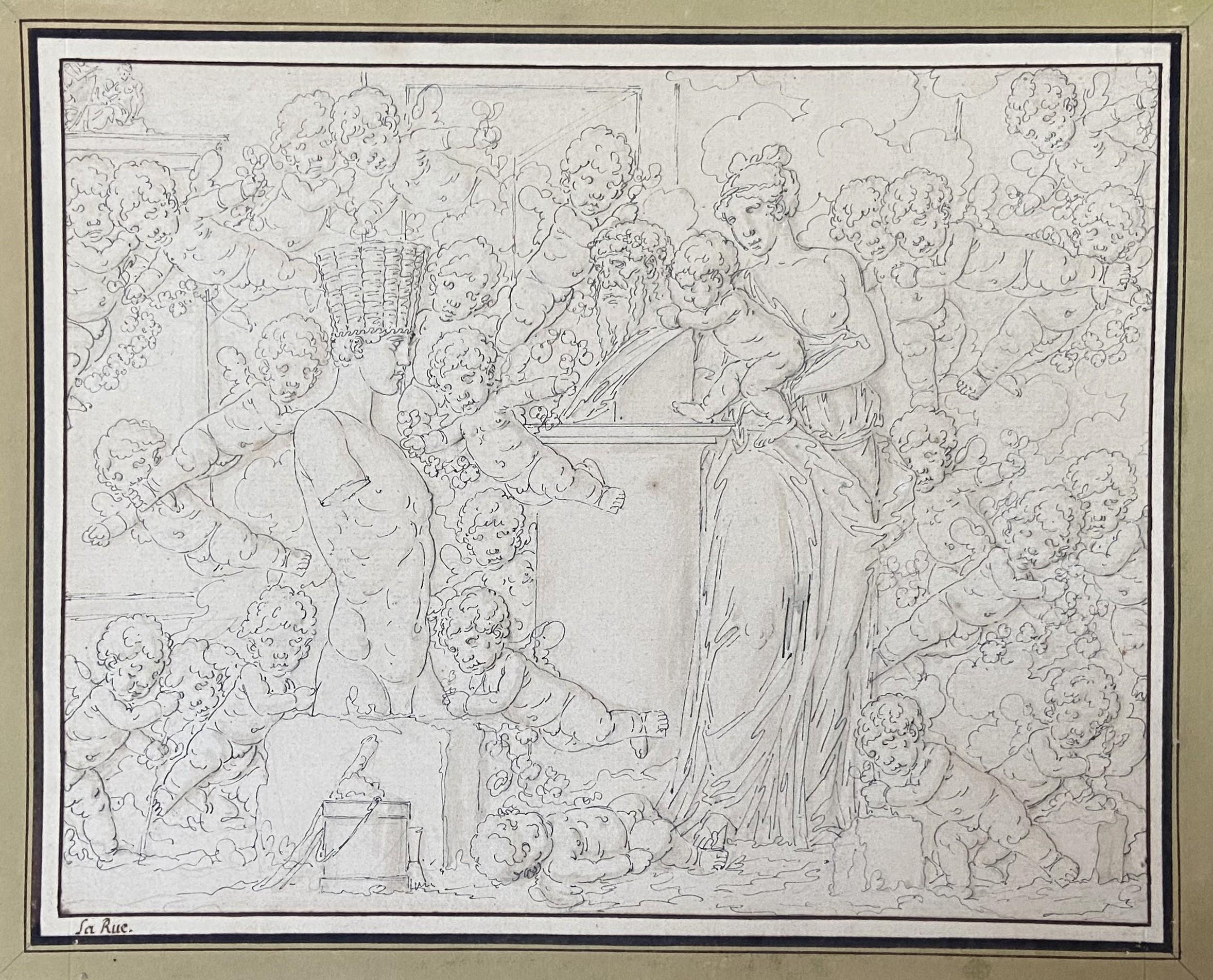Items Similar to Louis-Félix de La Rue (1730-1777) A Mythological scene, drawing
Want more images or videos?
Request additional images or videos from the seller
1 of 8
Louis-Félix DelarueLouis-Félix de La Rue (1730-1777) A Mythological scene, drawing1776
1776
About the Item
Louis-Félix de La Rue (1730-1777)
A biblical or mythological episode
Signed and dated lower right (under the mount, see photos of the drawing out of frame)
Black ink and black ink wash on paper 21 x 31 cm
In good enough condition, foxings and scattered spots.
Framed: 40 x 50 cm
It is quite difficult to identify with certainty what was the subject of this very rich scene, in which we see the intervention of angels opening a tomb or a monument.
This drawing is very characteristic of the delicate and very personal style of Louis-Félix de La Rue, who was a rather eccentric artistic figure, and who drew his own vision of mythology and ancient history in a pre-romantic, often pessimistic atmosphere as if he had felt that he was living in the last years of a historical era.
Louis-Félix de La Rue was born on October 19, 1730 in Paris, where he died on June 24, 1777. He was a draughtsman and sculptor, older brother of Philibert-Benoît de la Rue.
De La Rue was trained in the studio of the celebrated sculptor Lambert-Sigisbert Adam (1700-1759), where he may have met the young Clodion who, although some years Delarue’s junior, also worked under Adam. He won the prix de Rome in 1750 with a bas relief entitled "Abraham rendant grâces à Dieu de la délivrance de son fils" and became pensionnaire of the École royal des élèves protégés between 1752 and 1754. In this role, Delarue presented a group entitled Bacchante qui enivre des enfants and four bas-reliefs of the Saisons figurées par des enfants to the king during an exhibition at Versailles in 1754. Before going to Rome in November 1754, he worked under the direction of Jean-Jacques Bachelier at the Manufacture de Vincennes, where he made several groups of frolicking infants, including two presse-papiers models, referred to as ‘plaques à papiers La Rue’. Upon returning to the Académie de France in Rome, of which Natoire was the then director, he was admitted into the Academy of Saint Luke on 13 September 1760. Subsequently, De La Rue was named Professor, and, in 1762. After 1764, Delarue disappears from the official record and, tragically, is believed to have been plagued by physical frailty and mental illness.
- Creator:Louis-Félix Delarue (1730 - 1777)
- Creation Year:1776
- Dimensions:Height: 8.27 in (21 cm)Width: 12.21 in (31 cm)
- Medium:
- Movement & Style:
- Period:1770-1779
- Condition:
- Gallery Location:Paris, FR
- Reference Number:
About the Seller
5.0
Platinum Seller
These expertly vetted sellers are 1stDibs' most experienced sellers and are rated highest by our customers.
Established in 2018
1stDibs seller since 2019
209 sales on 1stDibs
Typical response time: <1 hour
- ShippingRetrieving quote...Ships From: Paris, France
- Return PolicyA return for this item may be initiated within 14 days of delivery.
More From This SellerView All
- French Neo classical school, Allegory of Time, original drawingLocated in Paris, FRNeo classical school, France, end of the 18th Century Allegory of Time, Pen and black ink on paper, gray ink wash 30.5 x 19 cm irregularly shaped In g...Category
1790s Old Masters Nude Drawings and Watercolors
MaterialsIndia Ink
- Louis-Félix de La Rue (1730-1777) A Mythological scene, drawingBy Louis-Félix DelarueLocated in Paris, FRLouis-Félix de La Rue (1730-1777) A Mythological scene Pen and black ink on paper Bears an old inscription with the name of the artist on the lower left bo...Category
1770s Old Masters Figurative Drawings and Watercolors
MaterialsInk
- G. A. Rochegrosse (1859-1938) Studies of men, original drawingBy Georges Antoine RochegrosseLocated in Paris, FRGeorges Antoine Rochegrosse (1859-1938) Studies of men, Pencil on paper 23 x 41.5 cm Signed lower right In good condition In a modern mount 41 x 52.5 cm Provenance: Estate of the...Category
1910s Symbolist Nude Drawings and Watercolors
MaterialsCarbon Pencil
- Attributed to Eugene Deully (1866-1933) A woman, study, drawingLocated in Paris, FRAttributed to Eugene Deully (1866-1933) A woman , study, Pencil and heightenings of white gouache on blue grey paper in two parts, the left part added ...Category
1890s French School Nude Drawings and Watercolors
MaterialsPencil
- G. A. Rochegrosse (1859-1938) Study for Les Trophées, original drawingBy Georges Antoine RochegrosseLocated in Paris, FRGeorges Antoine Rochegrosse (1859-1938) Study for "Les Trophées" carbon pencil on thin paper 15.5 x 19 cm Signed lower left In good condition In in its original mount (a tear in th...Category
1910s Symbolist Nude Drawings and Watercolors
MaterialsCarbon Pencil
- Henri Ottmann (1877-1927) Nude in the studio, drawing signedBy Henri OttmannLocated in Paris, FRHenri Ottmann (1877-1927) Nude in the studio signed lower right Charcoal on paper 37.5 x 31.5 cm In good condition In a modern frame : 53 x 46.5 cm Published under n°414 of the artist's catalogue raisonné (p 167 reproduced) published by Bernard Toublanc-Michel, Paris 2020 This drawing is a particularly interesting and touching example of Henri Ottmann's art. It shows his special technique, which gives priority to a kind of blur, and in this case it serves very well this scene of intimacy as if captured by stealth. Henry Ottmann was born on 10 April 1877 in Ancenis. He made his debut at the Salon La Libre Esthétique in Brussels in 1904 and took part in the Salon des Indépendants in Paris from 1905, the Salon d'Automne, the Salon de la Société Nationale des Beaux-Arts and the Salon des Tuileries. In 1911 and 1912, Ottmann exhibited at the Artistes de la Société Moderne at the Gallery Paul Durand...Category
1910s Post-Impressionist Nude Drawings and Watercolors
MaterialsCharcoal
You May Also Like
- The Martyrdom of the Santi Quattro CoronatiLocated in New York, NYProvenance: Private Collection, UK After initial training under Justus Suttermans and Vincenzo Dandini, in 1673 Anton Domenico Gabbiani embar...Category
17th Century Old Masters Figurative Drawings and Watercolors
MaterialsPaper, Chalk, Ink, Pen
- Three drawings by François Boucher in a mounting by Jean-Baptiste GlomyBy François BoucherLocated in PARIS, FRWe would like to thank Juliette Parmentier-Courreau of the Custodia Foundation for her welcome and support during the consultation of Glomy’s Journal des Ouvrages. This spectacularly large "feuille de desseins ajustés" commissioned by François Boucher from Jean-Baptiste Glomy is emblematic of the painter's art and mastery of rocaille. It is also fully representative of the taste of this period in the field of decorative arts. The largest of these three drawings, placed at the bottom of the composition, is particularly interesting: dating from around 1756, it constitutes a modello (apparently unpublished) for the frontispiece of the "Catalogue des tableaux de Monsieur de Julienne"), preserved in the Morgan Library in New York. 1. François Boucher, the master of French rocaille The extraordinary career of Francois Boucher was unmatched by his contemporaries in versatility, consistency and output. For many, particularly the writers and collectors who led the revival of interest in the French rococo during the last century, his sensuous beauties and plump cupids represent the French eighteenth century at its most typical. His facility with the brush, even when betraying the occasional superficiality of his art, enabled him to master every aspect of painting – history and mythology, portraiture, landscape, ordinary life and, as part of larger compositions, even still life. He had been trained as an engraver, and the skills of a draftsman, which he imbued in the studio of Jean-Francois Cars (1661 – 1738), stood him in good stead throughout his career; his delightful drawings are one of the most sought-after aspects of his oeuvre. As a student of Francois Lemoyne (1688 - 1737), he mastered the art of composition. The four years he spent in Italy, from 1727-1731, educated him in the works of the masters, classics and history, that his modest upbringing had denied him. On his return to Paris in 1734, he gained full membership of the Royal Academy of Painting and Sculpture with his splendid Rinaldo and Armida (Paris, Musée du Louvre). Although, throughout his career, he occasionally painted subjects taken from the Bible, and would always have considered himself first as a history painter, his own repertoire of heroines, seductresses, flirtatious peasant girls and erotic beauties was better suited to a lighter, more decorative subject matter. His mastery of technique and composition enabled him to move from large scale tapestry...Category
1750s Old Masters Figurative Drawings and Watercolors
MaterialsChalk, Ink
- Study in the Antique Style, a neoclassical drawing by Augustin PajouLocated in PARIS, FRIn this lively and fresh drawing, probably taken from one of the artist's notebooks, Pajou presents us with a composition freely inspired by antiquity, as a souvenir of a visit to th...Category
1750s Old Masters Figurative Drawings and Watercolors
MaterialsInk
- Study of a Fate at mid-body, a red chalk attributed to Giovanni da San GiovanniLocated in PARIS, FRThis spectacular red chalk drawing depicts an elderly woman, her eyes bulging, her hand stretched out towards the sky. This disturbing character, who seems close to dementia, and the elongation of her arm with its Mannerist overtones, plunge us into the Florentine artistic milieu of the first half of the 17th century. The proximity of this drawing to some characters in the fresco in the Pitti Palace representing The Muses, Poets and Philosophers chased from Parnassus, the last masterpiece of Giovanni da San Giovanni, leads us to propose an attribution to this artist and a dating of around 1635-1636. 1. Giovanni da San Giovanni, the painter of contradiction We take here the title of the monography dedicated to the artist by Anna Banti in 1977, which remains the reference book for this artist. The son of a notary, Giovanni Mannozzi, known as Giovanni da San Giovanni, abandoned his studies to go to Florence at the age of sixteen, where he entered the studio of Matteo Rosselli (1578 - 1650) around 1609 and enrolled in the Academy of Drawing Arts in 1612. Around 1615 he produced his first known works, mainly frescoes for the city's tabernacles. He became famous in Florence for his originality, combining an obsessive application to the study of drawing and the reading of poetry and history with a disheveled appearance. Between 1619 and 1620 he decorated the facade of the Antella Palace in Piazza Santa Croce, a decoration that still partly survives today. The death of Cosimo II in 1621 put an end to the Florentine building activity and Giovanni da San Giovanni left for Rome to find other sponsors with the painter Francesco Furini...Category
17th Century Old Masters Nude Drawings and Watercolors
MaterialsChalk
- Sleeping Boy - Drawing by Giovanni Fontana - 16th CenturyLocated in Roma, ITSleeping Boy is an original modern artwork realized in the 16th century by Giovanni Fontana. Ivory colored sheet attached on an ivory colored cardboard (...Category
16th Century Old Masters Figurative Drawings and Watercolors
MaterialsPaper, Pencil
- Study after Michelangelo’s “The Last Judgment”By Michelangelo BuonarrotiLocated in New York, NYItalian School, 16th Century Provenance: Private Collection, New York This intriguing drawing is a study by an anonymous 16th-century Italian artist after a vignette in Michelangelo’s fresco of The Last Judgement in the Sistine Chapel. The altar wall of the Sistine Chapel was already richly decorated when Pope Clement VII commissioned Michelangelo to paint his Last Judgment...Category
16th Century Old Masters Figurative Drawings and Watercolors
MaterialsPaper, Gouache





